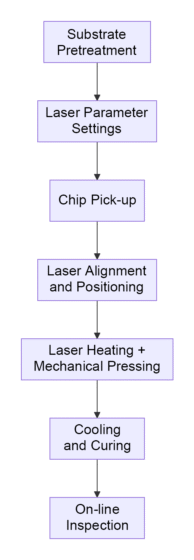1.Technical Principle
Achieves precision bonding between the chip and substrate through the synergistic interaction of high-energy laser pulses (with wavelengths of 980nm/1064nm) and mechanical pressure. Its core mechanisms include:
- Laser Thermo-Compression Effect: Laser energy is absorbed by bonding interface materials (e.g., solder/adhesive layers), instantly heating them to a molten state (200-350°C). Concurrently, a controllable pressure (10-50 N/cm²) is applied to promote atomic diffusion;
- Stress Compensation: A transparent pressure cap (e.g., quartz glass) combined with infrared temperature measurement enables real-time adjustment of pressure distribution, compensating for the coefficient of thermal expansion (CTE) mismatch between the chip and substrate;
- Micro-Region Precise Control: The laser spot size can be focused to 20 μm², enabling μBump-level bonding with a precision of ±1 μm.
2.Process Flow

3.Technical Advantages Comparison
| Indicator | Thermo-Compression Bonding (TCB) | Laser Compression Bonding (LCB) | Improvement Magnitude |
|---|---|---|---|
| Heating Rate | 5-10℃/s | 200℃/s | 20x |
| Heat-Affected Zone (HAZ) | >50μm | <5μm | Reduce by 90% |
| Bonding Pressure Uniformity | ±15% | ±3% | Increase by 80% |
| Minimum Bump Pitch | 30μm | 10μm | Reduce by 67% |
| Applicable Substrate Thickness | >100μm | 25-50μm | Expansion by 50% |
 DYNALAS
DYNALAS